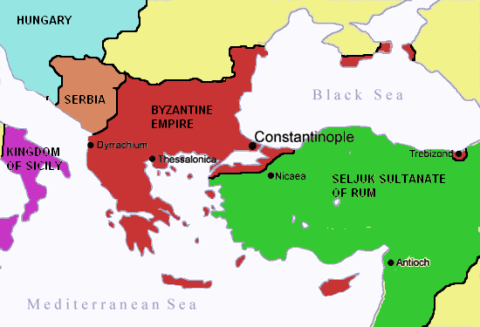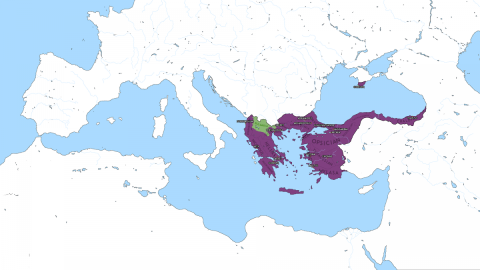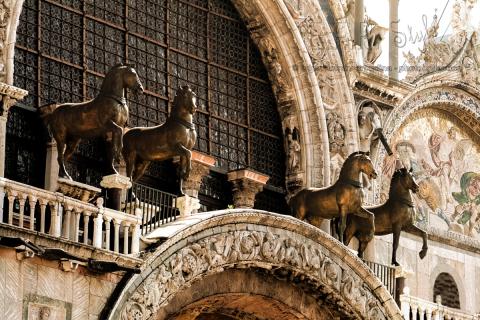Barbarians and Heretics: Anti-Byzantine and Anti-Western Sentiments in Crusade-Era Chronicles, 1096–1204
Of all the kingdoms and empires of medieval Europe, few have been mistreated by scholars throughout history more than the Byzantine Empire. These scholars often relied upon stereotypes contained in Western primary sources. The Byzantine Empire was located in modern-day Greece and Turkey and lasted for more than one thousand years, spanning the entirety of the medieval period. In 1869, the British historian and prominent Victorian-era moralizer W. E. H. Lecky described the Byzantines as “without genius or intellectual activity . . . degenerate . . . [with] no spark or semblance of nobility” (Lecky 1869, 18). To put it simply, as John Julius Norwich has in A Short History of Byzantium, “For the past 200 years and more, [The Byzantine] Empire has had an atrocious press” (Norwich 1997, xxxix). Fortunately, in the past couple of centuries and certainly in the decades since World War II, the field of Byzantine studies has thrived, and many previous stereotypes have fallen out of favor with scholars. However, these stereotypes are deeply rooted in European history, all the way back to the era of the Crusades, religious wars fought during the Middle Ages in the name of winning the Holy Land from the Muslims. My research demonstrates that these anti-Byzantine sentiments, alongside anti-Western sentiments among the Byzantines, frayed Byzantine-Crusader relations, ultimately culminating in the disastrous Fourth Crusade, which attacked the Byzantine Empire itself.

The author, Ryan Saputo
I have always been interested in the Byzantine Empire in general and particularly in the causes of the Fourth Crusade. I first discovered the Byzantine Empire when I was twelve years old, playing the video game Crusader Kings II. I was confused about the large purple area called the “Byzantine Empire” on the map where Greece and Anatolia were. I had never read or heard anything about medieval Greece, and I was a history buff even as a child. I then began reading online about the empire and learned that it was the last remnant of the Roman Empire and that its true name was the Eastern Roman Empire. I continued reading about the Byzantines in high school and knew that I wanted to take a class or do research on the Byzantines in college. The stories were so intriguing that I never lost interest.
In my junior year at the University of New Hampshire (UNH) I completed a research project on the Fourth Crusade as part of a seminar taught by Professor David Bachrach on the High Middle Ages. I then decided that a Summer Undergraduate Research Fellowship (SURF) could be a natural extension of the research I completed in that class. In Dr. Bachrach’s class I focused on scholarly works, but for the SURF, I focused entirely on both Byzantine and Western European primary sources.
The role that anti-Byzantine and anti-Western stereotypes played in Byzantine-Crusader interactions is an often-overlooked area of study. Too often scholars have blamed the events of the Fourth Crusade on actors such as the Venetians or the papacy instead of examining the deep-rooted, hateful sentiments between Byzantines and Western Europeans. I focused specifically on evidence of stereotypes held by both Byzantines and Western Crusaders in literary primary sources for my research.
Background
The Byzantine Empire, more accurately known as the Eastern Roman Empire, was the last remnant of the Roman Empire by the time of the Crusades. In 395 CE, the Roman Empire was divided into the Eastern and Western Roman Empires, each with its own emperors, militaries, and administrations, to ease the burden of administering such a large territory. The Western Roman Empire collapsed in 476 CE, but the Eastern Roman Empire—the Byzantine Empire—survived, finally falling only in 1453 CE. The Romans within the Eastern Empire, although speaking Greek, self-identified as Romans and called their empire the Roman Empire. In fact, the Byzantines never referred to themselves as “Byzantines.” The label “Byzantine Empire” was a historiographical term applied by Western Europeans to deny the Byzantines’ legitimacy as the continuation of the Roman Empire. For the sake of simplicity and recognition, I will refer to the empire as the Byzantine Empire.

The Byzantine Empire on the accession of Emperor Alexios I Komnenos (r.1081–1118), shortly before the First Crusade began. A daughter of Alexios I, Anna Komnenos, wrote an account of the First Crusade. Source: Wikimedia Commons
At its territorial height in 555 CE the Byzantine Empire controlled portions of Spain, Italy, North Africa, the Balkans, Egypt, and the Levant (the westernmost portion of the Middle East bordering on the Mediterranean Sea). However, in the succeeding centuries, it lost the Levant, Egypt, and North Africa to the Arab conquests in the seventh century, most of Italy to the Lombards in the sixth and seventh centuries, and most of the Balkans to the Slavs in the early seventh century. By 1096 CE, when the First Crusade began, the empire had been reduced to its heartland, modern-day Greece and Turkey. Its capital was Constantinople, modern Istanbul, a city whose population numbered in the hundreds of thousands and was the largest in Europe for centuries.
Since the empire’s inception, relations between the polities of Western Europe and the Byzantine Empire had been strained for a variety of reasons. The pope’s coronation of Charlemagne, a Frankish king, as Imperator Romanorum—“Emperor of the Romans”—in 800 CE was deeply offensive to the Byzantines, whose empire was the direct continuation of the Roman Empire. Western European kingdoms largely denied the Byzantine Empire’s claim of Roman-ness, and deliberately and insultingly referred to the empire as “the Kingdom of the Greeks.”
The Byzantines were Orthodox Christians; they split from Catholicism in 1054 CE and retained important religious differences from Western Christianity. For example, the Orthodox Byzantines followed the leadership not of the pope of Rome but of the ecumenical patriarch of Constantinople, appointed by the Byzantine emperor. Further, the Byzantines did not endorse the idea of holy war, unlike the Catholics; rather, the Orthodox Byzantines believed that every war the empire fought was holy, as the empire itself was ordained by God to be the only legitimate and universal empire in the world.
Additionally, the Byzantine Empire had intermittently warred with various Western European peoples, chief among which during the crusading period were the Normans, a hybrid of the Frankish and Norse peoples. The Normans launched repeated invasions into the Balkan provinces held by the Byzantine Empire, seeking total conquest. The empire managed to defeat these invasions, and this was the political and diplomatic climate in which the Byzantines began to hear rumors of the First Crusade in 1096. The Byzantines were immediately suspicious of the pending Crusade. According to Anna Komnene, the Byzantines suspected it was a disguise for a direct attack on the Byzantine Empire (Komnene 2009, 309–311).
Out of the nine numbered Crusades, only the first was successful. The second, fourth, fifth, and seventh Crusades were chaotic disasters, and the others achieved mixed results. Most people are unfamiliar with the role the Byzantine Empire played in the first four Crusades. For the first three, most of the Crusader armies marched directly through Byzantine lands to reach the Middle East, often pillaging along the way, though the Byzantines themselves were not (theoretically) the enemies of these Crusaders. The logistical circumstances required the Crusaders to negotiate with the Byzantines for supplies, transportation, and guides. Despite the best efforts of the Crusaders, the Byzantine Empire mostly did not participate directly in the expeditions but instead provided crucial logistical support.

The Byzantine Empire one year prior to the Fourth Crusade and the Sack of Constantinople. The Empire had been severely weakened by rebellions and wars in the preceding decades. Source: Wikimedia Commons
The Fourth Crusade, originally organized to invade Egypt, ultimately targeted the Christian Byzantines due to debt and the desire to force the Byzantines to join the Crusade, resulting in the deaths of hundreds of thousands of Byzantines and the temporary destruction of the empire. The Fourth Crusade has garnered scholarly debate for centuries, and there are a multitude of theories regarding its causes and origins. Some scholars claim that the Fourth Crusade was an unfortunate series of accidents with no one to blame, while others charge the Venetians or the papacy with premeditation or claim that the Fourth Crusade was the result of a grand clash of Eastern versus Western civilizations. However, the evidence I gathered from primary sources on both sides demonstrates that anti-Byzantine and anti-Western stereotypes led to significant deterioration in relations and in increasingly negative and violent Byzantine-Western interactions, which culminated in the Fourth Crusade and the sack of Constantinople.
Methods
As I planned my SURF research on the role of stereotypes in Byzantine-Western European interactions, I already had extensive background knowledge on the Byzantines and knew that I wanted to read many Byzantine primary sources, such as the Alexiad, Choniates’ and Kinnamos’ histories, De Administrando Imperio, the Taktika, and the Strategikon. However, I was much less familiar with the primary sources written by Western Europeans in this period of the Crusades. My faculty mentor, Dr. Bachrach, was critically important in recommending the most prominent primary sources from the West, such as Robert the Monk, Raymond d’Aguilers, the Gesta Tancredi, Albert of Aachen, Fulcher of Chartres, and Odo of Deuil. Throughout this project I relied heavily on the UNH library system, including interlibrary loan, to access primary and secondary sources.
I read all these primary sources translated from Latin or Greek into English. I also read two primary sources in the original Latin and wrote translations of them. These sources, the Devastatio Constantinopolitana and the letters of Count Hugh of St. Pol, were accessed online with Dr. Bachrach’s help. I took detailed notes, including quotes, from all these texts to be able to use that direct evidence later in drawing conclusions. A complete, annotated list of primary sources is found in the Appendix.
Results: Byzantine Perspective
The evidence I gathered demonstrates that the Byzantine attitude toward the First Crusade and all other succeeding Crusades until the Fourth was one of suspicion and terror. The Byzantine princess Anna Komnene wrote in the Alexiad regarding the arrival of the First Crusade, “[Emperor Alexios] dreaded their arrival, knowing as he did [the Latins’ (Western Europeans’)] uncontrollable passion, their erratic character and their irresolution, not to mention . . . their greed for money . . . which always led them . . . to break their own agreements without scruple” (Komnene 2009, 308). Anna clearly believed that her father, Emperor Alexios, was very suspicious of the character, supposed traits, and motivations of the Crusaders. She argued that the whole expedition was a plot to seize Constantinople (311) and to dethrone and replace the emperor (319). This evidence demonstrates that the Byzantine emperor of the time, Alexios Komnenos, deeply mistrusted the Crusaders and believed their ultimate goal was to attack Constantinople and destroy the empire or usurp its throne. Regarding specific actors within the Crusade, Anna called Tancred de Hauteville a “barbarian lunatic” (439) and Bohemond of Taranto a “rogue” (328). Furthermore, the Crusaders are always referred to as “Latin barbarian[s]” (317) within the text.
In the Second Crusade, the Byzantine historian Kinnamos compared the Crusaders to thieves for keeping former Byzantine lands for themselves (Kinnamos 1976, 33), again calling them “barbarians” (59), and portrayed the Crusade leaders as liars (63) and brutish lunatics (67). Between the Second and Third Crusades, a mob of Byzantines in Constantinople murdered Western European residents in the city and looted their property in an event known as the Massacre of the Latins (Choniates 1984, 141). Finally, regarding the Third Crusade, Niketas Choniates, another Byzantine historian, accused the crusaders of heresy (222), compared them to pigs (226), and lambasted them as evildoers (167). In short, the Byzantines believed that the Crusaders were “brazen-faced, violent men, money grubbers and . . . quite immoderate. These are the natural characteristics of the race” (Komnene 2009, 450). These beliefs are perfectly in line with the Byzantine worldview, inherited from the Romans: everyone who was not one of them was a barbarian. I extracted these quotes directly from the primary source material, and their prevalence throughout Byzantine sources over multiple centuries indicated that these were widely and deeply held beliefs.
Results: Crusaders’ Perspective
The Crusaders were no more trusting or friendly toward the Byzantines in their writings regarding the first four Crusades. For example, Raymond d’Aguilers, a First Crusade chronicler of the Crusade leader Raymond of Toulouse, wrote that Alexios’ actions were “the most fraudulent and abominable treachery” (d’Aguilers 1968, 23). Odo of Deuil, a Second Crusade writer, went further: “The Greek[s’ religious practices] . . . should be expiated by death . . . they were judged not to be Christians, and the Franks considered killing them a matter of no importance” (Odo of Deuil 1948, 57). Odo also recounts that “the Bishop of Langres, however, urged us to take [Constantinople]. He proved that the walls were weak, that the people were inert, and that . . . Constantinople is Christian only in name . . . [since] her emperor had ventured a few years previously to attack the Prince of Antioch . . . and [replace Catholic bishops] with heretics” (Odo of Deuil 1948, 71). Not only did Odo dehumanize the Byzantines entirely and claim that killing them did not matter, but he went further and agreed with calls to attack Constantinople itself. In the Third Crusade, an anonymous chronicler called the Byzantines “Greeklings” who were wicked and deceitful (The Crusade of Frederick Barbarossa , 2016, 53).
Overall, the Western chronicles largely present the Byzantine Empire not as a friendly Christian nation of kindred spirits in need of protection, as one might expect from the alleged reason for the Crusade in the first place, but merely as another obstacle that the Crusaders overcame—another miracle granted by God in their victory. This characterization is most present in texts from the First Crusade, by far the most successful of the Crusades. The failures of the Second and Third Crusades, however, meant that the narrative purpose of the Byzantine Empire within Western texts shifted. The empire was no longer an obstacle that they overcame, but an obstacle that prevented their success. The evidence above from Western primary sources demonstrates deeply held anti-Byzantine stereotypes among the Crusaders over multiple centuries.
Tensions Erupt with the Fourth Crusade
Through my research, I determined that the events of the Fourth Crusade were a result, at least in part, of culminating tensions between Byzantium and the West, and these tensions are evidenced in the firsthand accounts by both sides. Initially, the pope called for the Fourth Crusade to reconquer Jerusalem; instead, the Crusade never even reached the Middle East.
En route to the Middle East, the Crusade leaders and army became heavily indebted to Venice, whom they had contracted to build a transport fleet. Faced with unpayable debts, the Crusade leaders accepted a suggestion from the Venetians: they would sack the Christian Croatian city of Zara, a city that had revolted against Venetian rule, and use the loot to pay some of the debts in exchange for Venice’s continued participation in the Crusade. Eager to continue the Crusade no matter the price, the Crusade leaders accepted the deal and proceeded to sack Zara.

The Horses of St. Mark (Venice, Italy), one of the pieces of art looted from Constantinople in the 1204 sack. The horses were installed in St. Mark’s Basilica (as shown here) by the Venetians, who had participated with the crusaders in the attack and looting of Constantinople. Source: Wikimedia Commons
After the sack of Zara, an exiled Byzantine prince, Alexios IV Angelos, approached the Crusade leaders and offered them a deal too good to ignore: he would pay piles of gold, convert himself and the empire to Catholicism, and join the Crusade itself in exchange for help in gaining the Byzantine throne. The Crusade leaders, eager to escape debt, convert the “heretic” Byzantines, and force them to end their “backstabbing” and support the Crusade, agreed to this plan.
The Crusader fleet sailed for Constantinople, where the army overthrew the reigning emperor, Alexios III, and installed their usurper, Alexios IV, with few losses. When the usurper realized that it was politically impossible to convert either himself or the Byzantine populace to Catholicism, pay the Crusaders, or muster a large army to join the Crusade, he attempted to dismiss the Crusaders after minimal payments. Instead of leaving, the Crusaders decided that they would take Constantinople and rule the empire themselves. Against all odds, the Crusaders succeeded, brutally sacking the largest city in Europe at the time, destroying countless pieces of ancient art, and killing hundreds of thousands. The Crusaders, with the Venetians, established a new empire that lasted until 1261, when Byzantines regained control.
Conclusion
Overall, the evidence I found was quite conclusive. I had known from my prior readings that stereotypes and cultural/ethnic tensions played a role in the Fourth Crusade, but even I had not expected the Western chronicles to contain such outright hatred toward the Byzantine Empire, its religion, culture, and emperors. I had not expected the empire to be presented as an obstacle that the Crusaders overcame in their holy war. The vitriol, particularly directed toward the Byzantine emperors Alexios and Manuel Komnenos, was also shocking. In most Western sources the emperors were portrayed as almost cartoonishly evil in nature.
I was also surprised by how cynical the Byzantines were toward the Crusaders in every Crusade. Byzantine suspicion in the First Crusade is perfectly understandable: a large contingent of the Crusader army was made up of Normans, the Byzantines’ sworn enemies, led by a man who had previously invaded the empire. However, the Byzantine hostility toward the Crusaders in the Second and Third Crusades is less logical: although they experienced raiding from out-of-control crusading soldiers, and some factions genuinely did want to attack the Byzantines, many of the Western leaders genuinely wanted to pass through Byzantine lands to get to the Holy Land (Choniates 1984, 229). This research demonstrates that the accumulation of stereotypes and negative diplomatic experiences led to the Fourth Crusade; with more understanding and good faith diplomacy, perhaps the catastrophe that was the Fourth Crusade could have been avoided.
Personally, this project was crucial to my future as a student of history. This was my first fellowship and first experience conducting research where I maintained my own schedule. The research itself will be critical to my senior thesis examining the Fourth Crusade and its buildup in depth. I hope this fellowship will be the first of many in my future, as I plan to continue my history studies in graduate school.
I would like to thank my research adviser Professor Bachrach for meeting with me weekly over Zoom and providing key suggestions in selecting Western sources and assisting in the translation of Latin primary sources. I must also thank the Hamel Center for Undergraduate Research, who awarded me the Summer Undergraduate Research Fellowship. This project would also not have been possible without the donations of Mr. Dana Hamel and the Donald J. Wilcox Endowed Fellowship Fund, whose contributions directly funded the SURF program.
References
Choniates, Nicetas. O City of Byzantium: Annals of Niketas Choniatēs. Translated by Harry J. Magoulias.Detroit, MI: Wayne State University Press, 1984.
D’Aguilers, Raymond. Historia Francorum Qui Ceperunt Iherusalem. Translated by John Hugh Hill and Laurita Lyttleton Hill.Philadelphia: American Philosophical Society, 1968.
Kinnamos, John. Deeds of John and Manuel Comnenus. Translated by Charles M. Brand. New York: Columbia University Press, 1976.
Komnene, Anna. The Alexiad. Edited by E. R. A. Sewter. Translated by Peter Frankopan. London: Penguin Books, 2009.
Lecky, W. E. H. History of European Morals. New York, NY: Appleton, 1876.
Loud, G. A., trans. The Crusade of Frederick Barbarossa: The History of the Expedition of the Emperor Frederick and Related Texts. Abington, UK: Routledge, 2016.
Norwich, John Julius. A Short History of Byzantium. London: Viking Press, 1997.
Odo of Deuil. De Profectione Ludovici VII in Orientem: The Journey of Louis VII to the East. Edited by Virginia Gingerick Berry. New York: W. W. Norton, 1948.
Edgington, Susan. Albert of Aachen, History of the Journey to Jerusalem. Vol. 1, bks. 1–6 of The First Crusade, 1095–1099. Aldershot, UK: Ashgate, 2013.
Peters, Edward. The First Crusade: The Chronicle of Fulcher of Chartres and Other Source Materials. Philadelphia: University of Pennsylvania Press, 1971.
Raoul de Caen. The Gesta Tancredi of Ralph of Caen: A History of the Normans on the First Crusade. Translated by David S. Bachrach and Bernard S. Bachrach. Abington, UK: Routledge, 2010.
Robert the Monk. 2006. Robert the Monk’s History of the First Crusade: Historia Iherosolimitana. Translated by Carol Sweetenham. Aldershot, England: Ashgate, 2006.
Author and Mentor Bios
Ryan Saputo, from Westbrook, Connecticut, is a senior at the University of New Hampshire (UNH) pursuing a dual degree in history and classics. As a student in the University Honors Program he began working with his mentor, Professor David Bachrach, through a Summer Undergraduate Research Fellowship (SURF), on which he based his honors thesis. Through this project, he learned a great deal about Byzantine-Crusader interactions, specifically focusing on diplomatic and military incidents between the two sides during the first three Crusades. His research was conducted in the UNH library, where he analyzed a number of primary sources. These sources allowed him to learn about the people who lived through the Crusades directly from their personal experiences. He decided to submit this article to Inquiry after being contacted by our editors. After graduating with his bachelor of arts degree in spring 2022, Ryan will continue in the accelerated master’s program in history at UNH and later plans to pursue a Ph.D. in history. He is grateful that Inquiry has given him the opportunity to produce a published research article, as this achievement will demonstrate his research skills to graduate schools, bringing him closer to achieving his professional goals.
David S. Bachrach began teaching at the University of New Hampshire (UNH) in the Department of History in fall 2003, focusing on medieval Europe. He met Ryan Saputo in his prose seminar in high medieval history. Through this course, Ryan connected with Dr. Bachrach and asked him to advise his honors thesis, which they began work on in the summer of 2021. Dr. Bachrach explains that working with Ryan to shape this project and meeting to discuss progress on a weekly basis has been a very rewarding experience. He shared that he, too, learned from Ryan’s project, as he was not previously familiar with all the materials they covered. In the past, Dr. Bachrach has mentored quite a few undergraduate students pursuing extended research projects, but Ryan is his first Inquiry author. He believes that Inquiry is a great opportunity for students to learn how to write for a broad audience, which is an important skill to develop, as sharing research insights with specialized and general readers is a central responsibility of being a historian.
Copyright 2022, Ryan Saputo
